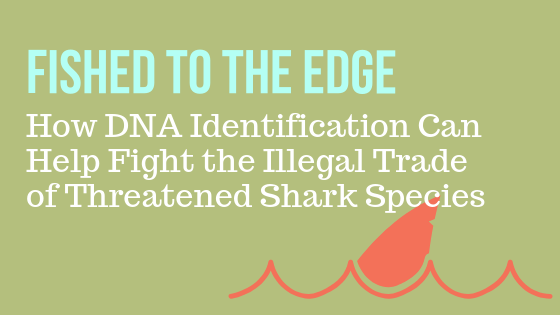Whether your first encounter was peering through the thick glass of an aquarium tank or peeking through your fingers in a darkened theater, there is something about sharks that captures our imagination. These fierce, and sometimes fearsome, creatures have existed in our oceans for over 400 million years, and survived multiple mass extinction events, including the one that killed the dinosaurs. They are not, however, the vicious, vengeful villain that some movies would have us believe. Sharks are apex predators, who play an important role in the world’s ocean ecosystem by regulating the population of prey species below them. Unfortunately, they are also part of one of the most threatened group of marine fish in the world. Of the more than 400 species of sharks that exist in our oceans today, approximately 15% are considered vulnerable, endangered or critically endangered.
Written by: Kelly Grooms, Promega
There are several factors that contribute to the vulnerable status of the world’s sharks. They typically have long lifespans, reach sexual maturity late, produce a low number of offspring and posses a low natural mortality rate. They are also targeted by fisheries around the world for both their fins and meat. An estimated 100 million sharks are killed every year. This has resulted in a dramatic decline in population numbers (1, 2).
The mangrove forest along the northern coast of Brazil is the largest continuous mangrove forest in the world, and a conservation hot spot for sharks. It also supports a major fishing ground. The abundant number of sharks in this area has made Brazil one of the top shark meat harvesters in the world (3,4). Nineteen different shark species live in this region. Eleven of these species are protected from harvesting by local or international laws.
Unfortunately, many sharks end up at the markets headless or finless, making species identification difficult and enforcing protective laws difficult. One group of Brazilian scientists believes that DNA can help identify the species of unknown shark samples (5). Between 2014 and 2016 these scientists collected and identified over 400 fin or muscle samples from sharks found in important fishery ports along Brazil’s North Coast.
Successful DNA identification relies on two things: 1) Having a sequence (or sequences) that can accurately distinguish the samples identity and 2) isolating DNA of sufficient quantity and purity to perform analysis. Used in tandem, the partial sequences of two mitochondrial genes (NADH Dehydrogenase Subunit 2 [NADH2] and Cytochrome Oxidase Subunit 1[COI]) can differentiate between the shark species endogenous to Brazil (5). A simple salt extraction method successfully isolated DNA from most samples. For samples that proved more difficult to extract DNA from, the scientists turned to a protocol developed to extract DNA from mouse tails using the Wizard® Genomic DNA Purification Kit.
The DNA typing approach identified seventeen different species among the samples analyzed (5). Unfortunately, nine of these seventeen are species listed as Threatened, and an additional four species belonging to species in the Near Threatened category. At the top of the list, the endangered Great Hammerhead and Scalloped Hammerhead sharks were the fourth and fifth most common species identified.
The clear evidence of the illegal trade of threatened shark species in this conservation hotspot is disheartening. That many sharks appear in markets headless and finless illustrate how difficult enforcing local or international protective laws can be. DNA identification can be used to distinguish shark species when common morphological indicators are missing, making it an efficient tool for law enforcement. With limited resources and a large proportion of small artisanal fisheries, Brazil faces some daunting challenges in policing the illegal trade of sharks.
References
- Stevens, J.D. et al. (2000) Sci. 57, 476–94.
- Davidson, L.N. and Dulvy, N.K. (2017) Ecol. Evol. 1, 0040.
- Barreto, R. R. et al. (2017) Policy 85, 114–122,
- Dulvy, N. K. et al. (2017) Biol. 27), 565–572,
- Feitosa, L.M. et al. (2018) Rep. 8, 3347.
WOULD YOU LIKE TO SEE MORE ARTICLES LIKE THIS? SUBSCRIBE TO THE ISHI BLOG BELOW!


